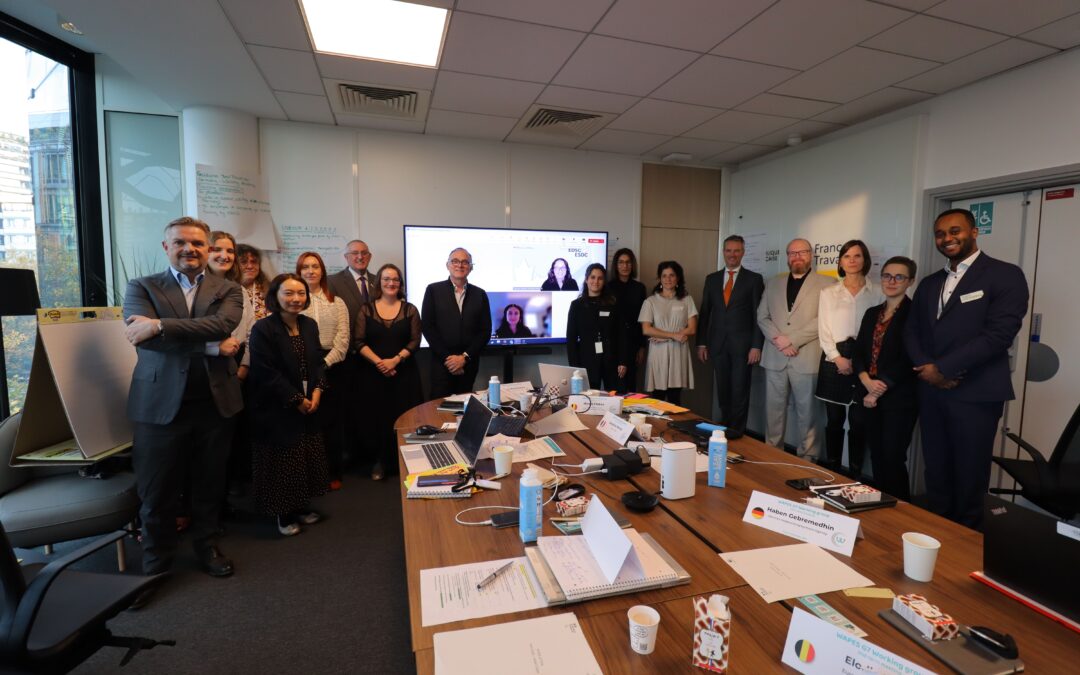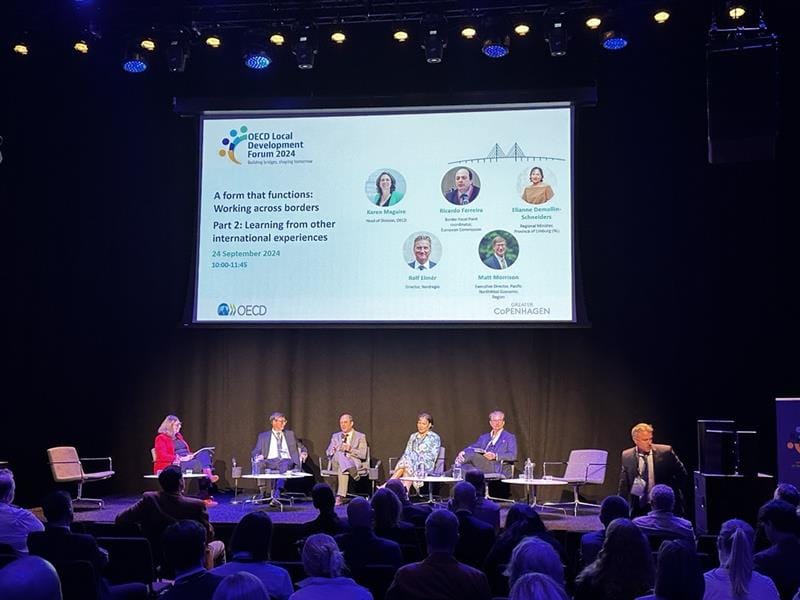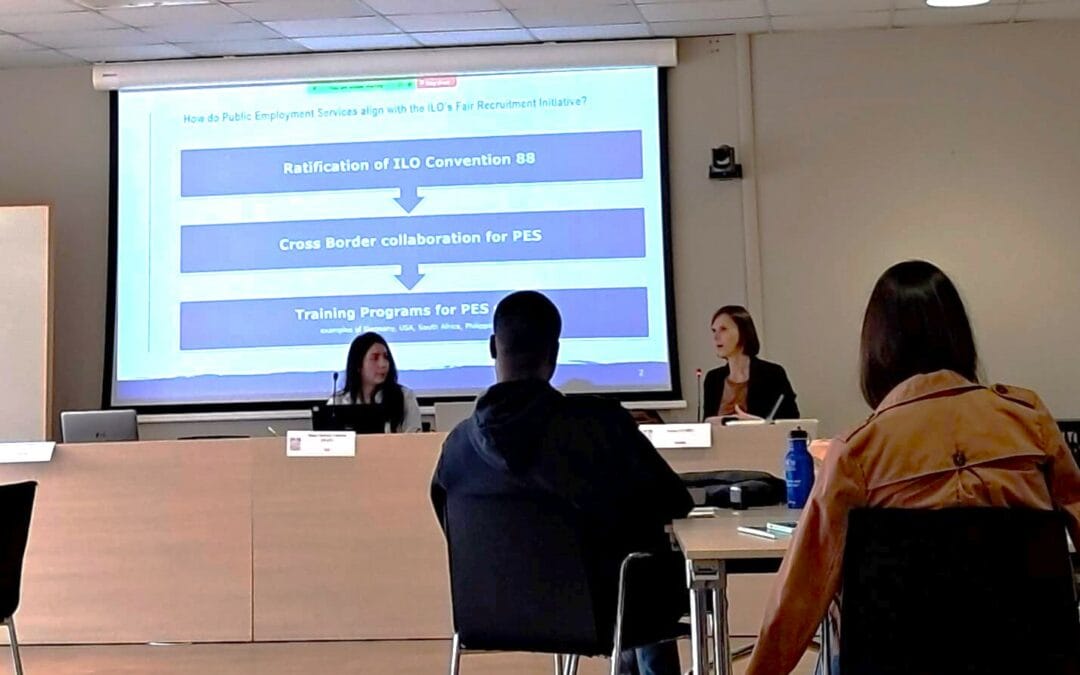Impact of global population ageing on employment and the labour market.
Introduction
The ageing of the population is a phenomenon that almost all countries of the world are facing today, in a movement more or less accentuated depending on the region, but visible everywhere.
This phenomenon, together with climate change, is becoming one of the most important factors in the economic and social transformations of our century, with effects on all structures of society.
We are already aware of the significant consequences for employment, the labour market and social protection systems. Sociologically, the ageing of the population also profoundly influences intergenerational relations, whether within family structures or in the world of work.
The retention of seniors in employment will increasingly be a factor in economic development and social cohesion. Therefore, anticipating the impacts of the ageing of the active population becomes an imperative of government policies and the action programmes of the Public Employment Services (PES).
A report from our senior consultant, Thierry HUORT
Give your opinion and share the best practices of your PES on this topic by visiting the dedicated forum in the member area.
Table of Content
A global context unprecedented in the history of humanity
Seniors, asset or burden? Prejudice in the world of work...
90% of working people over 55 say they are ready to change jobs.
Intergenerational diversity : a source of value creation for the company
4 generations working together in the company
Seniors in early retirement : A reserve of skills?
In OECD countries, less than 60% of 50 to 64 year olds are employed
The promises of the "Silver Economy"
2 billion older people in the world by 2050
Economic crises and ageing: Impact on pension systems and risks of impoverishment
+ 14%: This is the evolution of life expectancy between 1970 and 2019 in the OECD countries
Levers and practices to act
40% of the PES have integrated a priority in 2022 to keep seniors in employment
For more information
OECD and ILO reports, studies and data
Illustrated practices
France: Pôle emploi promotes job sharing for seniors
Europe: Mobilization of the European Social Fund (ESF)
A global context unprecedented in human history
Globally, the population aged 65 and over is growing faster than other age groups. According to the forecasts of the United Nations Report published in July 2019 on the State of World Population, by 2050, one in six people in the world will be over 65 years old (16%), compared to one in eleven in 2019 (9%).
In 2018, for the first time in human history, people aged 65 and older outnumbered children under five worldwide.
By 2050, one in four people living in Europe and North America will be 65 or older. The number of people aged 80 and over is expected to triple from 143 million in 2019 to 426 million.
Rising life expectancy and declining fertility rates are, first of all, the main factors influencing our demographics. But migration, movements at the global level also have important effects on the age structure of the population:
- In host countries, international migration can temporarily slow the decline and ageing of the population, since migrants tend to be young and working-age.
- The flip side of this situation is that these large migrations of young workers could ultimately contribute to accentuating the ageing of the population of the countries of origin, even if for the moment birth levels generally counterbalance this phenomenon.
Other causes, by systemic effect, can also influence this phenomenon: the increase in recent years, in many countries, including high-income countries, of often precarious jobs, low wage expectations and an insecure labour market, can also lead families to have fewer children or to have more children later in life. One of the immediate consequences of this slowdown is that the growth of the global labour force, as experts say, may not
%
The population aged 60 and over will increase from 1 billion in 2020 to 1.4 billion in 2030.
compensate for the rapid increase in the number of retirees, which will increasingly put pressure on both pension systems and labour markets.
As a result, in all countries, the share of older people in the workforce will increase. And it is a new progressive revolution for which institutions, public services, companies, and even the world of vocational training, must imperatively prepare.
According to the report’s analysis, population ageing is expected to lead to an increase in the average age of the working population, which is projected to rise from almost 40 years in 2017 to 41 years in 2030, with a much faster increase in Europe and East Asia, particularly in China.
In Europe, for example, Switzerland, along with Sweden (86%), Iceland (83.6%) and Estonia (81.3%) are among the countries in which more than eight out of ten people aged 50 to 64 were active (EU average: 70.3%) in 2020. According to a recent press release from the Federal Statistical Office (FSO), in Switzerland, more than a third (33.5%) of the working population was aged 50 or over in 2020, a share that has increased compared to 1991 (24%).
A high employment rate of the population over 50 has a positive impact on the economy and leads to the creation of new markets. European experts also predict that spending by people aged 50 and over will reach €6.4 billion by 2025 and will be responsible for almost 40% of the jobs created (source: European Commission). This is what has already been called for several years, the Silver Economy.
Seniors, asset or burden? Prejudice in the world of work…
According to the barometer conducted in France by the Defender of Rights and the ILO, 1age is, along with being a pregnant woman, the first criterion of discrimination felt by employees. Being over 55 years of age is considered a barrier to hiring by 82% of public sector employees, 81% of private sector employees and 89% of jobseekers. Age is a vector of many prejudices, both on the part of employers and workers themselves.
According to the 2018 barometer of a French association of recruiters “A compétences égales”, companies, recruitment agencies and senior candidates cite as the main “perceived” obstacles to hiring seniors: cost, difficulty in being managed, resistance to change, oversizing of the profile in relation to the position, or the question of the time remaining to work in the company.2
Most of these statements are nevertheless contradicted, according to the same study, by the answers of the seniors interviewed. Thus, 3 out of 4 seniors say they are ready to review their remuneration downwards (and even 8 out of 10 for executives), while more than 9 out of 10 people say they are ready to change functions.
In addition, the advantages of seniors expressed jointly by companies,
%
Working people over the age of 55 say they are ready to change jobs.
And today it is not uncommon to see start-ups, emerging from the digital economy, integrate into their development plan the recruitment of seniors in management, operations management, marketing or sales management functions.3
As for the question of “time remaining to work in a company”, it must be borne in mind that a 50-year-old employee still has well over ten years of professional life ahead of him or her. In addition, in a context of a tight labour market, senior employees are likely to show relative stability, greater loyalty to their company, and thus offer an answer to the problem of turnover that affects many companies.
Intergenerational diversity : a source of value creation for the company
This aging of the population has another effect for companies and their leaders who must now learn to deal with a new fact: to make three and soon four generations work together with differences in culture and in conception of the relationship to work that can generate as much synergy as tension.
The so-called “Baby Boomer” generation, the generation born between 1945 and 1965, is mainly composed of people who have been able to build their career on commitment to a growing post-war global economy, the valorization of experience and social achievements.
Then, the “X” generation, born between 1965 and 1980, experienced successive crises (oil shocks, fall of the Berlin Wall,..) and the appearance of mass unemployment. They learned ,at their own expense, flexibility and precarity , and in return a driving need to search for stability and security.
The “Y” generation, born between 1980 and 1995, now represents 50% of the world’s population and, according to several studies (Deloitte, Brookings Institute), it will represent 75% of the world’s workforce in 2025.
This generation, which grew up with ICTs, is “saturated” with the effects of the immediacy of the digital world. They also learned from the experience of the previous generation, the disillusionment and accidents
Generations working together in the company
And finally, the so-called Z generation, born after 1995, 32% of the world’s population, which today enters a company as digital addicts but eager for authentic relationships. Although, they have been hardened by successive crises (social, climatic, health ,..) , they are often far from being the prejudiced image of a passive and simply opportunistic generation. We can observe that they also know how to commit themselves and face the issues of our time with sincere engagement (climate risks, evolution of society, fight against discrimination, etc.), and with undoubtedly a more assertive sense of urgency than any other generation, and not hesitating to confront a previous generation (“OK boomer!”).
For companies and managers, this is a real challenge. It is not only a question of bringing together cultures that could at first appear irreconcilable, but of creating the conditions for them to work in synergy, mutually enriching each other with their differences in order to collectively face the challenges of tomorrow.
Seniors in early retirement : A reserve of skills?
The OECD, in its 2006 report “Living and Working Longer” already noted that less than 60% of people aged 50 to 64 were employed, a situation that already reflected early retirements. In some countries, early retirement is mainly based on certain provisions of pension systems or early retirement schemes, in others it is carried out through disability and other social benefits.
In all countries surveyed returns to work are rarer among older people – in general, less than 5% of inactive people aged 50 to 64 are employed one year after becoming unemployed.
For several decades, we have observed that seniors have as much difficulty keeping their job as finding one in the event of job loss.
As we have already discussed in the previous chapter, the obstacles to the resumption of employment, expressed on the side of employers, include:
a negative perception of the ability of older people to adapt to technological and organizational changes;
labour costs, both wage and non-wage, which increase more with age than with productivity;
and the difficulties that companies may encounter in adjusting their workforce, taking into account employment protection rules.
Older people themselves may feel (justified or not) that their human capital is depreciated, for example due to the effects of ageing on adapting to the demands and working conditions of certain jobs. But there is also the question of maintaining or developing their skills, often with little motivation on their part to mobilize the training opportunities available to them.
In fact, despite efforts with incentive policies, as in Europe with “Lifelong Learning”, the frequency of training decreases with age in all the countries covered by the study. This disinvestment is partly explained by the fact that the payback period of senior education is often considered too short, but also by comparatively lower levels of education, on average in these age groups and therefore less inclination to train.
Health problems and harsh working conditions may also play a role: many studies show that manual and low-skilled workers
%
of 50- to 64-year-olds are employed in OECD countries
This observation is part of a broader question of the ability of workers today, all generations combined, to keep pace with innovation and the increasingly rapid iteration of structural changes in the labour market, and, by the same logic, the adaptation of policies and mechanisms that will have to accompany them , with anticipation.
A reality noted by all PESs is that seniors who lose their jobs often find it very difficult to find work and often this is accompanied by a drop in salary.
On average across the OECD, the hiring rate for workers aged 50 and over is less than half the hiring rate for workers aged 25 to 49.
The low rate of return to work of older jobseekers reflects, as we have seen, the persistence of a reluctance on the part of employers to hire such workers. But it also reveals, let us not hide it, the absence of a shared conviction within the body of employment professionals, a certain amount of laxity with regard to job search obligations, and a more limited support provided by the PES to this category of jobseekers, compared to other categories (young people,..). Indeed, actions towards older jobseekers are often under-represented in active employment programs which are generally oriented towards other priorities.
The COVID-19 pandemic, in many countries, has had effects of increased closures for this category of assets and in other cases, effects of job transfers from one sector to another, aggravating pre-existing structural employment deficits in certain sectors of activity (hospitality, health professions, transport, construction, etc.) slowing down our recovery plans in most of our countries. Our governments are urging us to act urgently on unfilled job vacancies and on labour market tensions.
We are committed to mobilising all available labour reserves to support economic growth. Aren’t the currently inactive seniors then one of the main reserves of available labour that we could put back into motion?
The promises of the “Silver Economy” …
Under the label “seniors” hides in reality a great diversity of profiles from young active and autonomous retirees to dependent older people. Each of these profiles is a growing target that has specific needs, which innovations, adapted products and services will have to meet in the near future; It is this emerging sector that is termed the “silver economy”.
According to GlobalAgingCOnsulting4 there are three main groups of target individuals for products and services in the “silver economy”:
- so-called “active”, autonomous and independent seniors;
- so-called “fragile” seniors, with some limitations or decreases in capacity;
- so-called “dependent” seniors, who need help to perform everyday acts.
One of the main arguments of the “silver economy” is to improve the quality of life of all these people, whatever their profile,
of older people in the world by 2050
to guarantee their autonomy as long as possible, and thus to extend their life expectancy. In other words, it is a question of adapting as well as possible to their singularities.
This leads to an unexpected diversification of trades and jobs in the sector. While some professions are directly related to medical activity and care, others focus fully on social and relational dimensions. The ageing of the population will thus create or develop many job opportunities in areas such as housing, transport, leisure and communication. Not to mention the new technologies that are oriented towards assistance to people.
Economic crises and ageing: Impact on pension systems and risks of impoverishment
The income received by pensioners is mainly the result of their individual professional and salary background and the rules in force at the time when pension rights were accumulated.
In addition to the different characteristics of social protection systems, the rate of paid activity of men and women, their wages and the length of their working lives are fundamental determinants of their retirement income.
Unlike previous generations, many of today’s employees have been or are facing increasing job insecurity as well as the need for professional transitions and retraining that is often experienced.
The employment relationship has gradually evolved towards more flexible, but often more precarious, schemes, such as part-time work, fixed-term contracts, and various forms of self-employment that have developed in particular with the digitalization of the economy.
The various economic crises and structural deficiencies in the education-employment relationship have regularly led to delayed and often difficult entries into the labour market. The integration or reintegration support programs planned by governments have not always taken into account the issue of pension contributions.
Furthermore, subsequent life events (e.g. motherhood and child-rearing) affect the amount of pensions, depending on the pension scheme, as a result of the potential length of periods of paid employment. Women’s often fragmented career paths and persistent pay gaps are also factors affecting the amount of pensions. According to a 2015 OECD study, gender disparity is particularly pronounced when it comes to family responsibilities: a quarter of women, but barely 4% of men left their jobs to care for a loved one (2015 data).
An example illustrates the risks of this generational disparity in employment: Between 1990 and 2000, following the burst of
%
This is the evolution of life expectancy between 1970 and 2019 in OECD countries
The generation of workers who graduated from university or high school between about 1990 and 2004 is referred to as the Employment Ice Age generation.
This generation, which entered the labour market in a period of recession, had to face a very tight market, offering few opportunities and therefore found itself in a situation of having to accept non-regular, precarious and low-paid jobs. As the Japanese economy gradually recovered, companies stuck to a very traditional recruitment policy of hiring new graduates en masse, leaving the “Ice Age generation” excluded from more stable, better-paying job opportunities.
The working population of this generation is now in an age range between 30 and 40 years.
Many people in this generation are therefore at risk of not being able to benefit from sufficient income when they reach retirement age, unless they have family support to help them.
The Japanese government has therefore set itself the goal of stimulating and prioritizing regular employment for the workers of this generation over the next three years by offering them intensive support.
This example illustrates the long-term impacts that cyclical situations of precarious employment can have on the vulnerability of certain categories of the population and the need to identify the risks, and to prevent them through proactive actions.
Levers and practices to act
In its study, the OECD has grouped the practices of its member countries around two main areas of action:
- Encouraging enterprises to recruit and retain older workers
- Preventing age discrimination in employment
- Taking a balanced approach to employment protection by age
- Discouraging “mandatory” retirement for employers
- Encouraging the social partners to review seniority pay adjustment (HLG) systems and give priority to increasing skills
- Encouraging good practices in companies for the maintenance and management of a “generationally diverse” workforce
%
Some PES have integrated a priority in 2022 to keep seniors in employment
- Promoting the employability of workers throughout their working life
- Increase participation in training for mid- and late-career workers
- Provide effective employment assistance to older job seekers
- Improving the quality of employment for older workers
For more information
OECD studies and data
Table of good practices (OECD – Download)
UN reports and data

Illustrated practices:
France : Pôle emploi promotes job sharing for seniors
https://www.pole-emploi.fr/actualites/a-laffiche/seniors-boostez-votre-employabil.html
In France, work-sharing companies (WSC) can be created with the sole purpose of providing client companies with qualified personnel that they cannot recruit themselves due to their size or resources. The employee’s mission can be full or part-time. A contract must be signed, for each assignment, between the timeshare company and the client company, and an employment contract must be signed between the employee made available and the timeshare company. Temporary work companies can also carry out the activity of timeshare company.
The use of timeshare initially concerned only a small part of the working population, until the French law on the professional future of 2018, extended this device to a larger number of profiles. Now, people can be hired on a timeshare basis who:
- Who have particular difficulties in finding employment
- Who have been registered as unemployed for at least six months
- Who are recipients of minimum social benefits
- Who are disabled or over 50 years old
- Who have a low level of qualification
Europe : Mobilization of the European Social Fund (ESF)
The ESF is Europe’s main employment support mechanism: it works to help people find better jobs and to create fairer employment opportunities for all EU citizens. With a budget of €10 billion per year, the ESF improves the employment prospects of millions of Europeans, with a particular focus on those who have the most difficulty in finding work.
Several ESF projects aim to promote “active aging” among older workers and job seekers.
These projects encourage them to update their current knowledge (which may be outdated), to train for new skills if needed, to learn about new technologies, and to discuss changes in work practices with their employers. The ESF offers tailored approaches to encourage older people to work longer and continue to make their valuable contribution – a key factor in mitigating the effects of an aging workforce – as well as specific initiatives to encourage companies to hire older job seekers.
Mid-term meeting of the G7 working group in Paris
Mid-term meeting of the G7 working group in Paris Mid-term meeting of the G7 working group in Paris On 13 November 2024, the mid-term meeting of the G7 working group, organised by WAPES, was held in Paris on the premises of France Travail. This event was part of a series…
The Managing Board meets in Paris
The Managing Board meets in Paris Paris hosts the Board of Directors of the World Association of Public Employment Services (WAPES) On 14 and 15 November, Paris is hosting the managing board meeting of the World Association of Public Employment Services (WAPES). This event brings together representatives of public employment…
Report on OECD LEED September 2024 Meeting
Report on OECD LEED September 2024 Meeting Insights and Innovations in Labor Market Solutions: Report on OECD LEED September 2024 Meeting Location: Copenhagen, Denmark and Malmö, Sweden Executive Summary of the OECD LEED Meeting held in Malmö and Copenhagen on 24th and 25th of September, 2024 The OECD LEED meeting,…
WAPES takes part in ILO training on fair recruitment processes
WAPES takes part in ILO training on fair recruitment processes Report on WAPES Representation at Torino Event (22 – 23.10.24) The World Association of Public Employment Services with Consultant Ms Nicole Clobes participated in a vital training course at the ITC ILO Training Center in Torino, focusing on Establishing Fair…
WAPES Signs Declaration of Intent with the European Training Foundation!
WAPES Signs Declaration of Intent with the European Training Foundation! WAPES Signs Declaration of Intent with the European Training Foundation! We are thrilled to announce that WAPES has officially signed the Declaration of Intent with the European Training Foundation! This partnership marks a significant milestone in our commitment to enhancing…
Official launch of preparations for the 13th WAPES World Congress!
Official launch of preparations for the 13th WAPES World Congress! Official launch of preparations for the 13th WAPES World Congress! We are pleased to announce that preparations for the World Congress of the World Association of Public Employment Services (WAPES) have officially begun! Scheduled for early May 2025, this event…
WAPES Joins the Prestigious LEM Declaration of G7 Ministers
WAPES Joins the Prestigious LEM Declaration of G7 Ministers WAPES Joins the Prestigious LEM Declaration of G7 Ministers September 2024 - In a ground-breaking achievement, the World Association of Public Employment Services has been officially included in the Labour and Employment Ministers Declaration by the G7 Ministers. This notable inclusion…
Launch of the first issue of the “TA3AWON NEWS” newsletter
Launch of the first issue of the “TA3AWON NEWS” newsletter Launch of the first issue of the "TA3AWON NEWS" newsletter We are pleased to announce the publication of Issue 01 of "TA3AWON NEWS", the newsletter dedicated to international cooperation in the field of employment, published by the Agence Nationale de…
WAPES European Region Workshop: Responding to skills Shortages in Lugano
WAPES European Region Workshop: Responding to skills Shortages in Lugano WAPES European Region Workshop: Responding to skills Shortages in Lugano On 4 and 5 September 2024, the city of Lugano in Switzerland hosted the regional workshop of the European region of the International Association of Public Employment Services (WAPES). This…
Creation of the G7 Working Group on Public Employment Services and Demographic Change
Creation of the G7 Working Group on Public Employment Services and Demographic Change Creation of the G7 Working Group on Public Employment Services and Demographic Change Brussels, 05th of June, 2024 WAPES is delighted to announce the formation of a G7 Working Group comprising our esteemed members from Canada, the…












